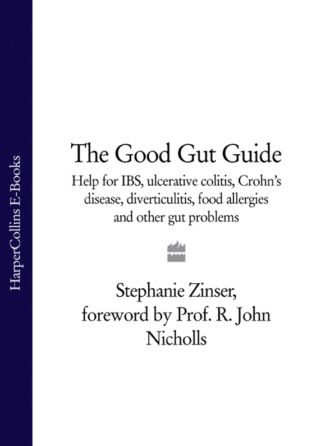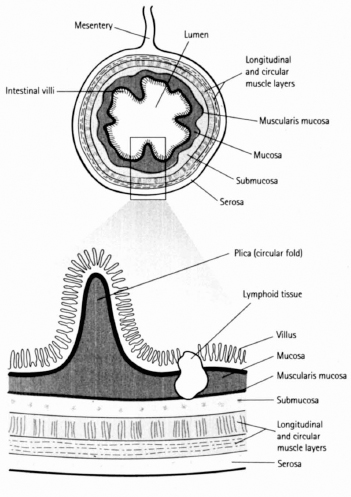
Полная версия
The Good Gut Guide: Help for IBS, Ulcerative Colitis, Crohn's Disease, Diverticulitis, Food Allergies and Other Gut Problems

The Large Intestine – the Colon, Rectum and Anus
Once food has travelled through the small intestine, most of the essential nourishment has already been absorbed. What enters the colon is watery slurry. It passes through the ileo-caecal valve into a stretchy section of the colon called the caecum. The appendix hangs down from the caecum and is a relic, doctors believe, from when the human diet was far higher in plant matter than it is today. The appendix may have contained special bacterial agents that digest cellulose – much like grass-eating animals have. In the colon, water is reabsorbed from the watery slurry, making the waste more solid. What have now become faeces (‘poo’) slowly travel along the last portion of the colon until they reach the rectum, where they are expelled through the anus.
Bacteria flourish in huge numbers in the colon. Even though they are present in the stomach and the small intestines, there is generally too much activity (and acidity) in these areas for them to thrive. But in the colon, the waste passes through much more slowly and the environment becomes increasingly alkaline, allowing bacteria to multiply in vast numbers. However, these bacteria serve a useful purpose – not only do they help break down much of the remaining undigested material, but they also reduce the wind that is generated as waste slowly passes through the colon. There are exchanges of various hormones as well – for example, excess oestrogen in the blood is passed through the walls of the colon, and, if the diet is high in fibre, it binds to this fibre and can then be excreted. Otherwise, it would be reabsorbed back into the blood. Scientists now realize that too much of certain oestrogens in the body can be a contributory factor in the development of many ‘hormonal’ cancers – like breast cancer, ovarian and cervical cancers, even prostate and testicular cancers in men. Minerals can also be reabsorbed into the body here.
Food travels slowly through the colon – the average journey time is 12–48 hours to get through this 1½–2 metre (5–6ft) long tube. The colon walls secrete mucus to lubricate the waste matter and help it move along smoothly. In fact, mucus-secretion happens all the way along the gut – coming from a thin layer of cells called the mucous membrane. This membrane also protects the gut wall against bacteria and the acidity of the digestive enzymes, and helps ensure that it is our food and not our gut that gets digested when we eat. The rectum is about 15cm (6in) long and lies between the colon and the anal canal. It acts as a reservoir for the faeces. When it becomes full, nerve endings trigger strong muscular contractions that make us want to empty our bowels. This happens when the anal sphincter muscles open, allowing the waste to be expelled.
Конец ознакомительного фрагмента.
Текст предоставлен ООО «ЛитРес».
Прочитайте эту книгу целиком, купив полную легальную версию на ЛитРес.
Безопасно оплатить книгу можно банковской картой Visa, MasterCard, Maestro, со счета мобильного телефона, с платежного терминала, в салоне МТС или Связной, через PayPal, WebMoney, Яндекс.Деньги, QIWI Кошелек, бонусными картами или другим удобным Вам способом.




